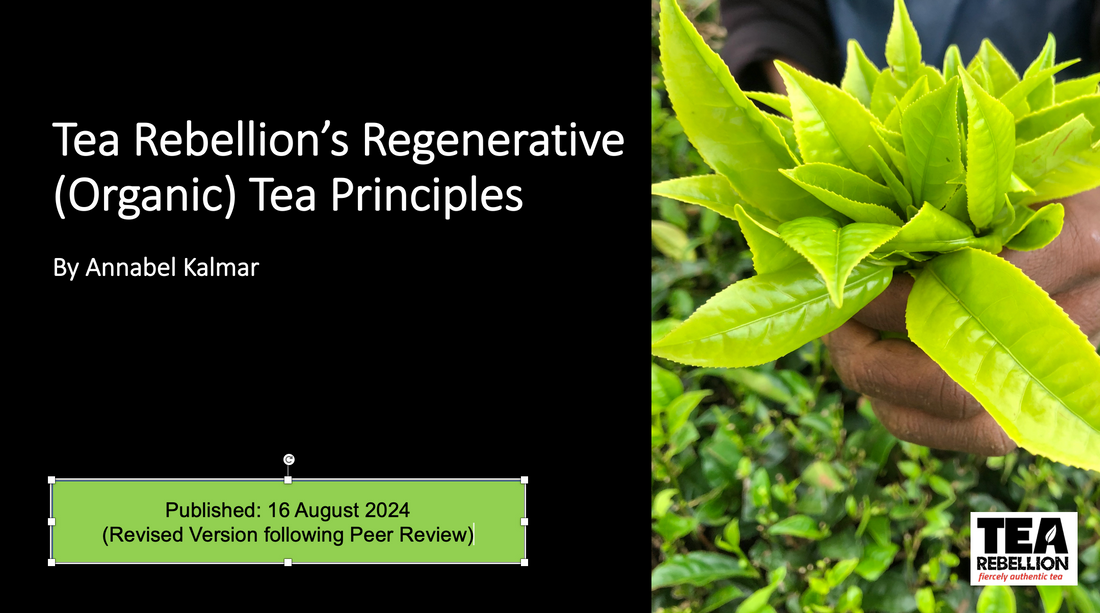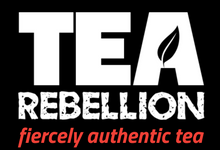
Tea Rebellions Regenerative Organic Tea Principles
On this version
This is the second and revised version following feedback from peers on the first version published June 27 2024 linked here (in its original form) https://tearebellion.com/blogs/blog/tea-rebellions-regenerative-organic-tea-standards. To those who took the time to provide feedback a huge THANK YOU! Your peer review feedback was insightful and timely. Key points we incorporated are.
- Terminology: It was pointed out that the original name which included Standards had an inherent clash with the approach describing a journey. So in this version we have revised this to "Principles" which is much more in line with our general thinking.
- Comprehensiveness: These principles are not in their current form aiming to be a comprehensive sustainability farm level outcome measurement. In fact so far we only looked at the key factors impacting Soil Health (Soil, Biodiversity, Carbon, Organic Matter) and have not yet discussed other nature benefits outside of Soil related ones. We also do not cover any socio-economic factors which a comprehensive assessment might include.
- Regionalisation: When talking with our partner farmers in Malawi it turns out that there are already following a complete no till policy for their tea plantations, even during replanting.
- Next steps: The project around "Pilot Action" is in scoping right now. Please drop us an email if you would like to input into the concept paper
Introduction
As part of our 2024 Strategy project which aims to increase farmer action and returns from regenerative tea farming (see visual below), we are talking to our partner farms, farming experts and third party sustainability service providers to understand the state of play and bottlenecks to adoption. This blog sets out our Regenerative Organic Tea farming Practices. The project on pilot action is in scoping in parallel.
Diagram 1: Tea Rebellions 2024 Strategic Objectives on Regenerative Action
Our Approach to Regenerative tea farming
We have decided to take an iterative approach where we articulate a first set of practices based on current applications in organic farming and insights from carbon sequestration research. This is already a peer reviewed version which we will continue to iterate over time.
We believe that adopting regenerative practices is a journey for both farmers and the supply chain. Organically farming tea farmers are usually already following several regenerative practices. For example many tea farmers are already farming without fertilizer, using shade crops, returning organic matter to the soil, doing no till and following other practices that will be included in our practices below. However, regenerative farming goes beyond with its active focus on improving soil health and ecosystem resilience.
For us regenerative organic tea farming at the current time (August 2024) is about..
|
Measurement |
NOT |
Certification/Compliance |
|
Journey |
NOT |
Destination |
Why an iterative, learning based approach?
Through our travels to Tea Rebellion partner tea farmers we noticed that many tea farmers are struggling with keeping up to date on organic, rainforest alliance and other requirements and audits. We want to embrace innovation and continuous learning so we have chosen a phased approach (also often referred to as maturity approach), in order to remove the initial adoption hurdles and make it easier “ to get on the train”.
The aim is for our partner farmers (and other tea farmers) to adopt more and more practices over time and continuously measure & scale what works in their ecosystem. We understand Regenerative Tea Farming to not be an absolute but rather a Journey to Maturity.

Intended outcomes for a Perennial Farming System (continuous, i.e. no crop rotations)
The intention behind regenerative organic tea farming is to enhance soil health and system resilience. Most of the innovation, research and new technical applications are tested in arable/annual farming systems where the focus is on how to manage crop rotations to the benefit of a healthy system. However tea (like cocoa, coffee and most plantation style crops) is a perennial. In the case of tea this means that the plant is planted today and after 3 years you can first harvest and then keep doing so for about 30 years. With a focus on soil fertility and system resilience, here are some central principles:
-
Enhancing organic matter and natural nitrogen- since we are removing nutrients in the form of plucked leaves and pruned leaves we need to return some nutrients back to the soil. The best form is annual manure or compost, yet few larger tea farms have enough animals on them to make this work well. Composting is a great option but one that requires some technical knowledge and lots of attention. Other options include nitrogen fixing soil cover crops or shade trees.
-
Enhancing biodiversity - This is necessary both for the microorganism in the soil and above it for ecosystem resilience. Sadly there is a trade off with organic matter as often soil microorganisms can be washed out in more water retaining soils more easily. Biodiversity is attractive from a farming perspective for natural pest management and because it attracts birds and smaller wildlife. It is also worth thinking about connecting natural habitats so that you can build wildlife corridors with your farm and create nature co-benefits this way.
- Avoiding soil disturbance to allow carbon build up - Since we are interested in the build up of soil carbon over time and creating a carbon sink through tea farming we need to ensure we do not disturb and set carbon free on a regular basis.
Figure 1: Key factors affecting Soil Health and Ecosystem Resilience

Figure 2: Tea Rebellions Regenerative Organic tea farming practices (V2)
|
Practice |
Description |
Benefit |
Relevance for Tea Sector |
|
Minimize Till |
No till farming grow crops without turning/ |
Avoids loss of carbon/increases carbon below ground Retains soil moisture |
Tillage is only usually done when deep pruning happens (every 2-3 yrs on some farms others less frequently or none at all). The bare soil is then often tilled, mulched or even planted to avoid weed growth. |
|
Recommendation |
|
||
|
Practice |
Description |
Benefit |
Relevance for Tea Sector |
|---|---|---|---|
|
Intercrop/` Cover Crop/ Agroforestry |
Increase farm biodiversity and ecosystem resilience through multiple crops |
Provides natural nutrients esp. if alternate crops is nitrogen fixing Retains water at different soil depths if different root systems Retains moisture due to topsoil coverage Prevents erosion/landslides |
Agroforestry and shade trees are common on tea farms, while intercropping is not. We need to pilot and document the cost & benefits of different options in different ecosystems & soils. |
|
Recommendation |
sun cover, biodiversity boost, nitrogen fixation and revenue stream |
||
On Measurement, Certification & Your Input
We are aware of the following two divisive topics in the regenerative space:
- What should we baseline & measure, i.e. which proxies are best?
- Should organic certification be a perquisite to become regenerative or not?
This blog is aimed at practitioners and its overall aim is to advance practical action. For this reason we have decided to "park topics 1 and 2" and plan to focus more on these points in future events and discussions round as well as in "Pilot Action" project in scoping right now.
Thank you for reading to this point. This signals to us that you care about the potential of regenerative transformation for the tea sector and the wider food system. Please share your comments on these draft standards to info@tearebellion.com so we can strengthen these standards further to benefit smallholders, cooperatives and the tea supply chain.

